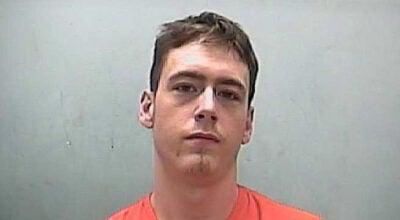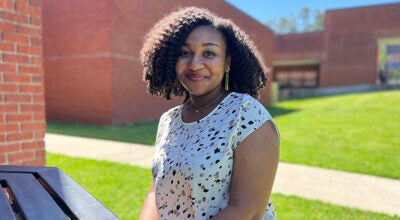‘Guilty’ & repentant: Jury returns quick verdict, judge issues life sentence
Published 12:03 am Friday, November 16, 2012

LAUREN WOOD / THE NATCHEZ DEMOCRAT — Adrian Williams, left, stares at the ground as he stands with defense lawyer Tim Cotton while Judge Forrest “Al” Johnson sentences him to life in jail without eligibility for release until he is 65. Williams was found guilty Thursday afternoon of the May 2011 murder of Quinton Brown.
NATCHEZ — The words Terracine Prater heard Thursday afternoon won’t bring her son back, but they did wash her in a feeling of closure.
“Guilty” was the verdict delivered by an Adams County jury in the murder trial of Adrian Williams.
Williams, 22, was on trial for the shooting death of Prater’s son Quinton Brown, 17. He will serve life in prison without the eligibility for release until he is 65.
Prater said she holds no hatred for Williams.
“I am relieved,” she said after the sentencing. “God bless both the families, I am just glad justice has been served.”
A passerby found Brown dead in the Natchez City Cemetery on May 29, 2011. He had been shot five times, including in the back and the head.
Williams hung his head and asked for forgiveness from Brown’s family just before Judge Forrest “Al” Johnson sentenced him.

LAUREN WOOD / THE NATCHEZ DEMOCRAT — Quinton Brown’s mother Terracine Prater, right, reacts while District Attorney Ronnie Harper delivers closing arguments in the trial of Adrian Williams.
The sentence came just minutes after a jury found Williams guilty of murder after 40 minutes of deliberation in the conclusion of the two-day trial.
“He was like a brother to me,” Williams said as he faced Brown’s family. “I just pray you forgive me.”
Johnson called the evidence against Williams “overwhelming” and added that he did not understand what could have happened to warrant Williams shooting Brown.
“It’s a tragedy,” he said. “I don’t understand why it has to be like this. I look at all these guns entered into evidence, and everybody involved in this case shouldn’t be running around with guns … high-caliber guns that are good for nothing but killing someone.”
Johnson said senseless crimes in Natchez like the one that took Brown’s life must stop.
“I don’t know what the solution is, but this has got to stop,” he said.
The closest thing the trial had to eyewitness testimony came first thing Thursday morning, when Denzel Fort took the stand.
Fort pleaded guilty in March to accessory after the fact in connection with the killing.
Fort told how he, Williams and Keldrick Washington picked up Brown, who they found standing on Beaumont Street at approximately 3 a.m. the morning of the crime. According to Fort, the three men asked Brown if he wanted to come with them to test out pistols.
“We hadn’t decided (where to go) until Adrian thought of the place to go,” Fort said.
That place was the Natchez City Cemetery. All of the men had guns, Fort said.
When they arrived at the cemetery, Washington, Brown and Williams all walked down to the cemetery. Fort said he stayed in the vehicle because he was on the phone with his girlfriend and he did not want her to know where he was or what the group was doing.
“They walked down the hill approaching the cemetery, and before they got all the way down Keldrick came back and said (Adrian) had wanted to see my gun, he wanted to test it,” Fort said.
A short while later, Fort heard a shot followed by several more shots, he said.
“After that, I saw Keldrick running back,” Fort said. “Keldrick got in the van, and that was when (Adrian) was coming back over. When I saw (Adrian) coming I asked where was Quinton, (Keldrick) said he was dead.”
Fort said when Williams got back in the vehicle, he threatened the other two men.
“He said if we said anything, we was going to die,” Fort said.
The men then drove to Williams’ mother’s house.
“We got out of the van and (Williams) tossed me back my pistol, and I looked at him and asked him did he shoot and kill Quinton with my pistol and he said no, so I asked him again and said, ‘Don’t lie to me, did you kill Quinton with my pistol,’ and he said no,” Fort said.
Fort said after returning home, he could not sleep. He checked the clip on his gun, found bullets missing and took the remaining bullets out of the weapon before hiding them and the gun in an abandoned structure near his grandmother’s residence.
Later, when he found out the police were looking for them, Fort and Williams went to the police station, where they were questioned. Fort admitted in court he did not tell investigators the truth at first, though later he did tell them what he told the court.
“I was scared being in that type of situation, who would want to be involved in a murder?” Fort said. “I eventually told the truth because I had a conscience, and it really bothered me.”
Fort told the court he did not actually see what happened in the cemetery nor did he have any idea who shot which gun.
In statements read in court Wednesday, Williams gave police three stories. The first story he told police was that he had seen Brown that night but he was not involved in the killing.
The second story he told — which was while making an official police statement — was that the men had gone to the cemetery for Brown and Fort to fight and that the victim had pulled a gun on Fort, and that Williams had shot him before Fort took the gun and also shot Brown.
The third story — which was, according to investigators, made only moments after telling the second — was that Williams was the only shooter and that he had thrown the guns into the Mississippi River. Testimony from Natchez Police Lt. Craig Godbold stated that Williams eventually told police where to find the guns investigators believe were used in the killing in exchange for a cigarette.
The court also heard from Adams County Coroner James Lee, who identified bullets that were removed from the victim’s body, and from Carl Fullilove Jr., a ballistics expert for the Mississippi state crime lab.
Fullilove said he was able to match two of the bullets to the class characteristics of one of the guns police recovered and four bullets to the class characteristics of a second gun, but he could not positively say the bullets were fired from those weapons.
Fullilove said the two weapons identified as sharing the class characteristics with the weapons that fired the bullets that killed Brown were a .357 Smith and Wesson revolver and an EAA .357 revolver that police recovered after Williams told them where to find the weapons used in the killing.
Class characteristics include the caliber of the weapon, the lance grooves in the barrel, the twist of the barrel, all of which are characteristics that are predetermined by gun manufacturers, Fullilove said
“I cannot say (the bullets used in the murder) were fired in these guns or were not fired in these guns,” he said. “There are other firearms out there that have the same class characteristics as these firearms. There are millions of them.”
Washington is also charged with murder in connection with the killing, but is being tried separately. He is scheduled to go to trial Nov. 27.





